Abstract
The generation of hydrogen peroxide (H2O2) and the derivative free hydroxyl radical (. OH) in cultures of mouse cells grown in the presence of visible light and ambient oxygen was shown previously to be implicated in chromatid damage. Furthermore, chromosome alterations appear to be associated with the spontaneous neoplastic transformation of mouse cells in culture. An attempt was made in this study to reduce the incidence of chromosomal aberrations and delay or prevent the onset of spontaneous neoplastic transformation of freshly isolated mouse cells, both fibroblasts and epidermal keratinocytes, by adding catalase to the culture medium, shielding the cultures from wavelengths less than 500 nm and providing a gas phase of 0-1% O2. These conditions significantly decreased the incidence of chromosomal aberrations in both cell types, and in fibroblasts prevented tumourigenicity in non-irradiated syngeneic mice, and increased latent periods for tumour development in X-irradiated mice. The epidermal keratinocytes were particularly resistant to spontaneous neoplastic transformation under all conditions tested. These observations on the protective effect of extracellular catalase suggest that H2O2, a normal metabolite, and/or the derivative .OH can directly or indirectly produce genetic damage and neoplastic transformation in mouse fibroblasts.
Full text
PDF
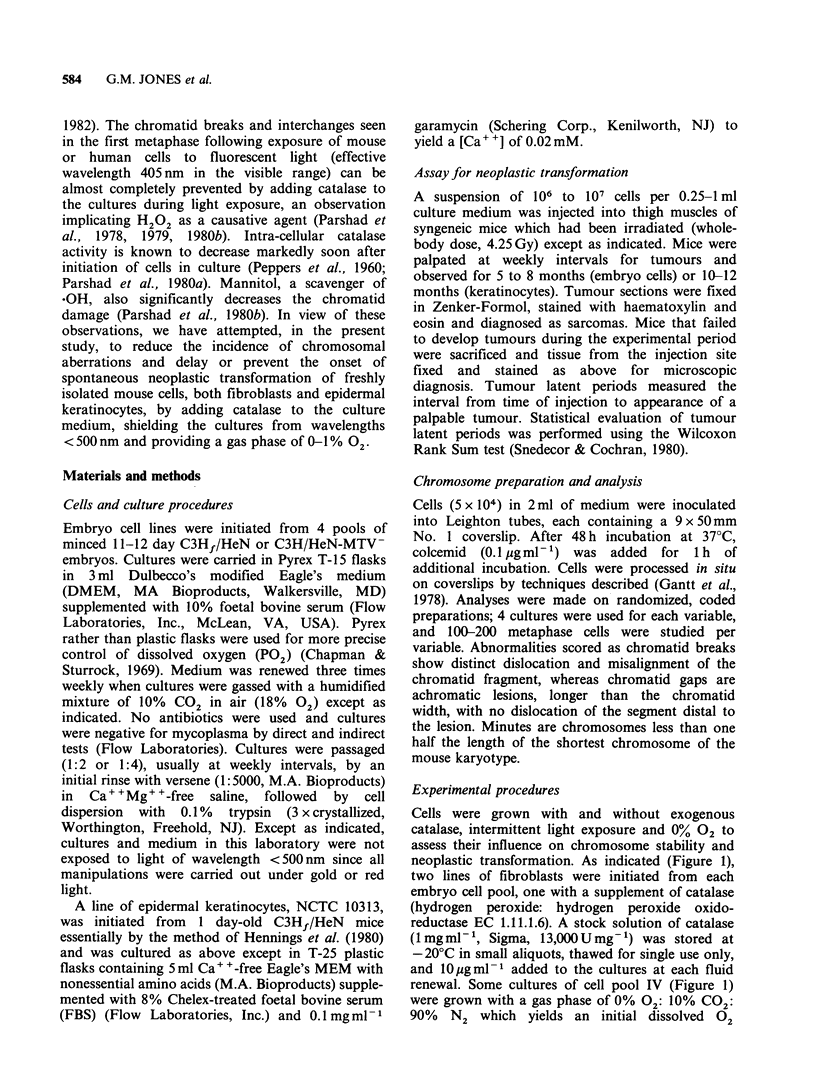

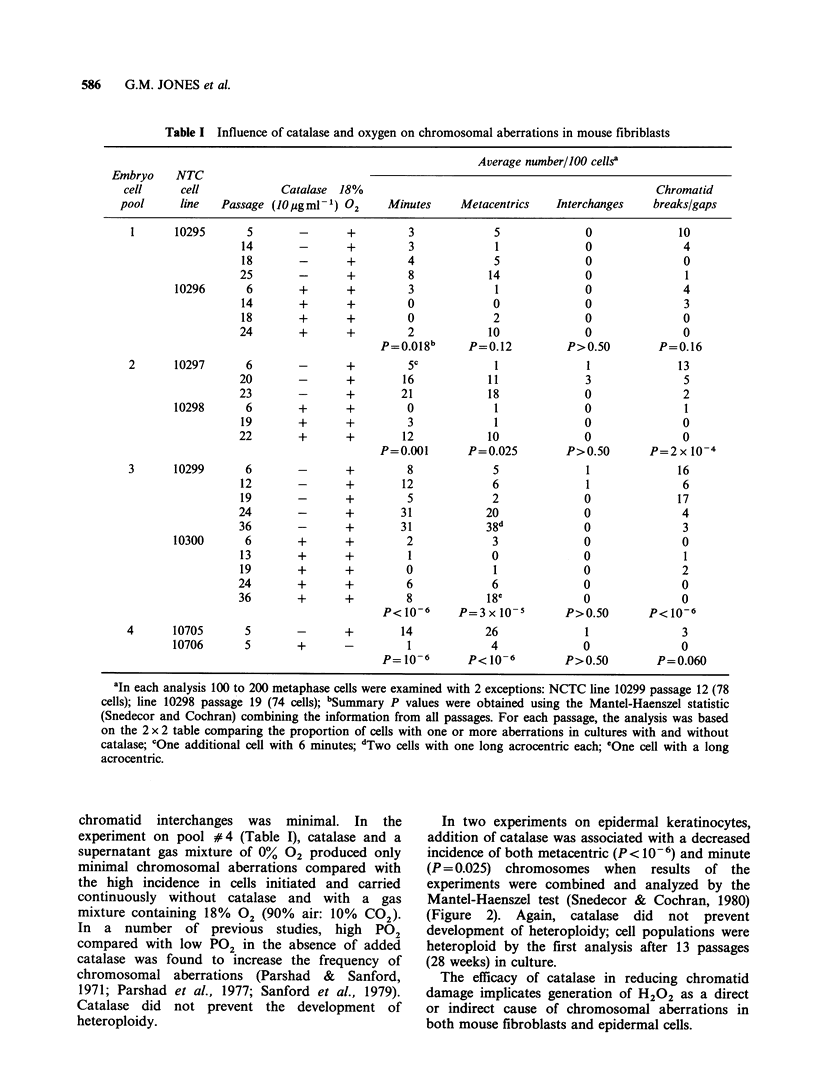

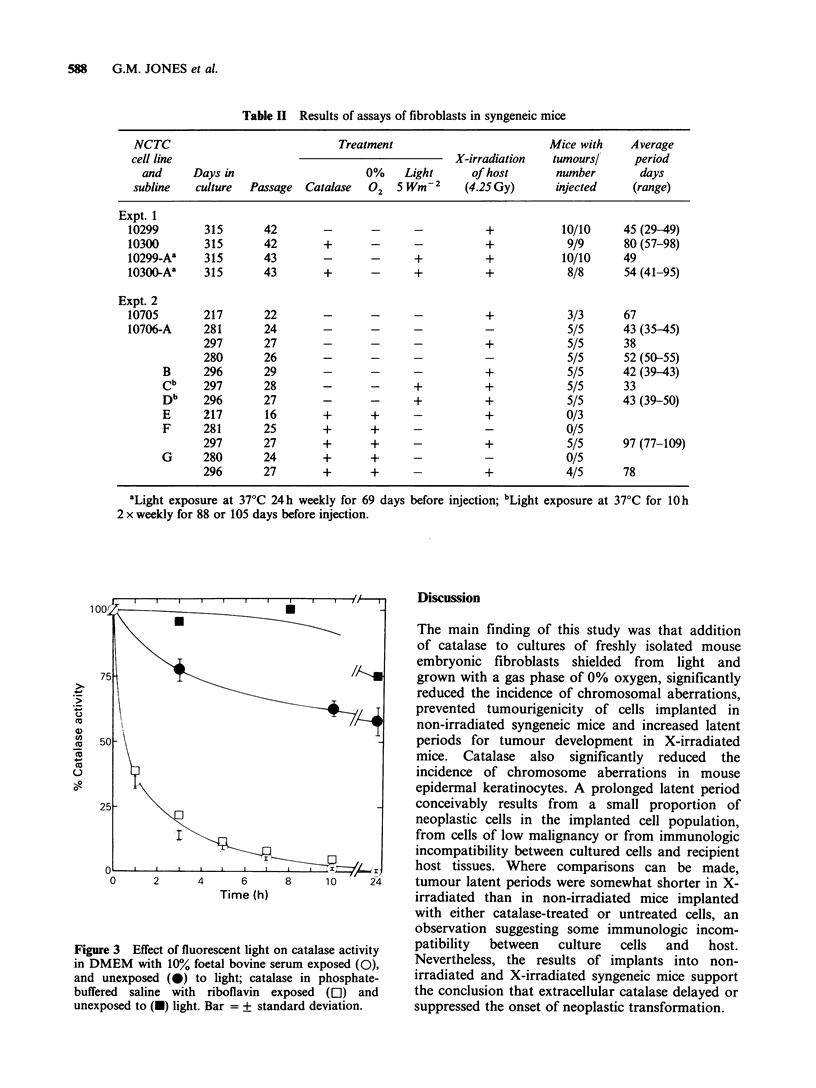
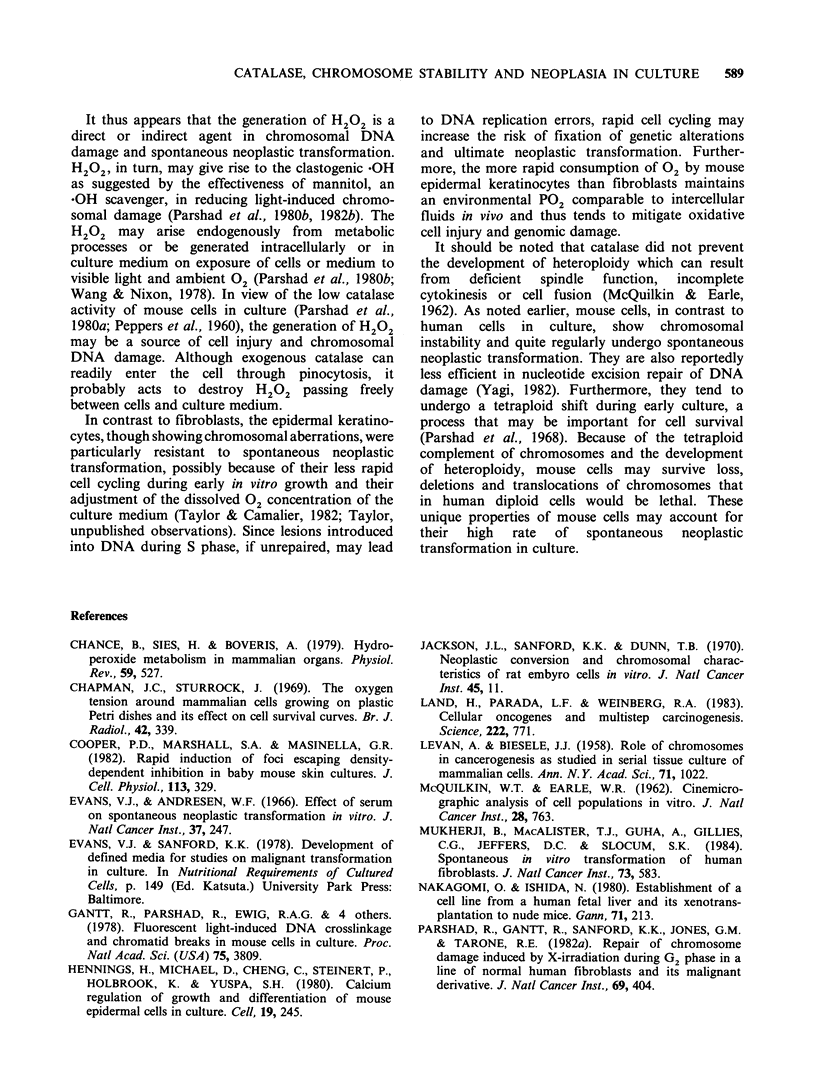
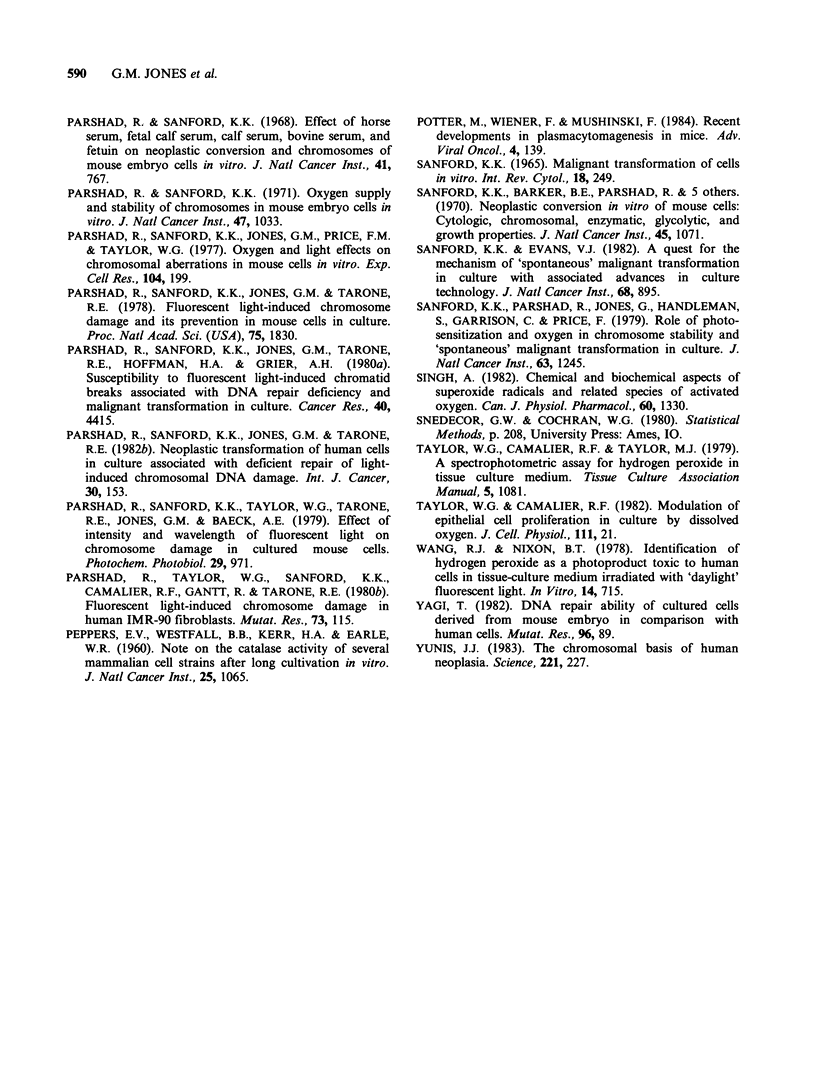
Selected References
These references are in PubMed. This may not be the complete list of references from this article.
- Chance B., Sies H., Boveris A. Hydroperoxide metabolism in mammalian organs. Physiol Rev. 1979 Jul;59(3):527–605. doi: 10.1152/physrev.1979.59.3.527. [DOI] [PubMed] [Google Scholar]
- Cooper P. D., Marshall S. A., Masinello G. R. Rapid induction of foci escaping density-dependent inhibition in baby mouse skin cultures. J Cell Physiol. 1982 Nov;113(2):329–336. doi: 10.1002/jcp.1041130223. [DOI] [PubMed] [Google Scholar]
- Evans V. J., Andresen W. F. Effect of serum on spontaneous neoplastic transformations in vitro. J Natl Cancer Inst. 1966 Aug;37(2):247–249. [PubMed] [Google Scholar]
- Gantt R., Parshad R., Ewig R. A., Sanford K. K., Jones G. M., Tarone R. E., Kohn K. W. Fluorescent light-induced DNA crosslinkage and chromatid breaks in mouse cells in culture. Proc Natl Acad Sci U S A. 1978 Aug;75(8):3809–3812. doi: 10.1073/pnas.75.8.3809. [DOI] [PMC free article] [PubMed] [Google Scholar]
- Hennings H., Michael D., Cheng C., Steinert P., Holbrook K., Yuspa S. H. Calcium regulation of growth and differentiation of mouse epidermal cells in culture. Cell. 1980 Jan;19(1):245–254. doi: 10.1016/0092-8674(80)90406-7. [DOI] [PubMed] [Google Scholar]
- Jackson J. L., Sanford K. K., Dunn T. B. Neoplastic conversion and chromosomal characteristics of rat embryo cells in vitro. J Natl Cancer Inst. 1970 Jul;45(1):11–23. [PubMed] [Google Scholar]
- LEVAN A., BIESELE J. J. Role of chromosomes in cancerogenesis, as studied in serial tissue culture of mammalian cells. Ann N Y Acad Sci. 1958 Sep 30;71(6):1022–1053. doi: 10.1111/j.1749-6632.1958.tb46820.x. [DOI] [PubMed] [Google Scholar]
- Land H., Parada L. F., Weinberg R. A. Cellular oncogenes and multistep carcinogenesis. Science. 1983 Nov 18;222(4625):771–778. doi: 10.1126/science.6356358. [DOI] [PubMed] [Google Scholar]
- Mukherji B., MacAlister T. J., Guha A., Gillies C. G., Jeffers D. C., Slocum S. K. Spontaneous in vitro transformation of human fibroblasts. J Natl Cancer Inst. 1984 Sep;73(3):583–593. [PubMed] [Google Scholar]
- Nakagomi O., Ishida N. Establishment of a cell line from a human fetal liver and its xenotransplantation to nude mice. Gan. 1980 Apr;71(2):213–219. [PubMed] [Google Scholar]
- PEPPERS E. V., WESTFALL B. B., KERR H. A., EARLE W. R. Note on the catalase activity of several mammalian cell strains after long cultivation in vitro. J Natl Cancer Inst. 1960 Nov;25:1065–1081. [PubMed] [Google Scholar]
- Parshad R., Sanford K. K. Effect of horse serum, fetal calf serum, calf serum, bovine serum, and fetulin on neoplastic conversion and chromosomes of mouse embryo cells in vitro. J Natl Cancer Inst. 1968 Sep;41(3):767–779. [PubMed] [Google Scholar]
- Parshad R., Sanford K. K., Jones G. M., Price F. M., Taylor W. G. Oxygen and light effects on chromosomal aberrations in mouse cells in vitro. Exp Cell Res. 1977 Jan;104(1):199–205. doi: 10.1016/0014-4827(77)90082-9. [DOI] [PubMed] [Google Scholar]
- Parshad R., Sanford K. K., Jones G. M., Tarone R. E. Fluorescent light-induced chromosome damage and its prevention in mouse cells in culture. Proc Natl Acad Sci U S A. 1978 Apr;75(4):1830–1833. doi: 10.1073/pnas.75.4.1830. [DOI] [PMC free article] [PubMed] [Google Scholar]
- Parshad R., Sanford K. K., Jones G. M., Tarone R. E., Hoffman H. A., Grier A. H. Susceptibility to fluorescent light-induced chromatid breaks associated with DNA repair deficiency and malignant transformation in culture. Cancer Res. 1980 Dec;40(12):4415–4419. [PubMed] [Google Scholar]
- Parshad R., Sanford K. K., Jones G. M., Tarone R. E. Neoplastic transformation of human cells in culture associated with deficient repair of light-induced chromosomal DNA damage. Int J Cancer. 1982 Aug 15;30(2):153–159. doi: 10.1002/ijc.2910300205. [DOI] [PubMed] [Google Scholar]
- Parshad R., Sanford K. K. Oxygen supply and stability of chromosomes in mouse embryo cells in vitro. J Natl Cancer Inst. 1971 Nov;47(5):1033–1035. [PubMed] [Google Scholar]
- Parshad R., Sanford K. K., Taylor W. G., Tarone R. E., Jones G. M., Baeck A. E. Effect of intensity and wavelength of fluorescent light on chromosome damage in cultured mouse cells. Photochem Photobiol. 1979 May;29(5):971–975. doi: 10.1111/j.1751-1097.1979.tb07800.x. [DOI] [PubMed] [Google Scholar]
- Parshad R., Taylor W. G., Sanford K. K., Camalier R. F., Gantt R., Tarone R. E. Fluorescent light-induced chromosome damage in human IMR-90 fibroblasts. Role of hydrogen peroxide and related free radicals. Mutat Res. 1980 Nov;73(1):115–124. doi: 10.1016/0027-5107(80)90140-2. [DOI] [PubMed] [Google Scholar]
- Sanford K. K., Barker B. E., Parshad R., Westfall B. B., Woods M. W., Jackson J. L., King D. R., Peppers E. V. Neoplastic conversion in vitro of mouse cells: cytologic, chromosomal, enzymatic, glycolytic, and growth properties. J Natl Cancer Inst. 1970 Dec;45(6):1071–1096. [PubMed] [Google Scholar]
- Sanford K. K., Evans V. J. A quest for the mechanism of "spontaneous" malignant transformation in culture with associated advances in culture technology. J Natl Cancer Inst. 1982 Jun;68(6):895–913. [PubMed] [Google Scholar]
- Sanford K. K. Malignant transformation of cells in vitro. Int Rev Cytol. 1965;18:249–311. doi: 10.1016/s0074-7696(08)60556-2. [DOI] [PubMed] [Google Scholar]
- Sanford K. K., Parshad R., Jones G., Handleman S., Garrison C., Price F. Role of photosensitization and oxygen in chromosome stability and "spontaneous" malignant transformation in culture. J Natl Cancer Inst. 1979 Nov;63(5):1245–1255. [PubMed] [Google Scholar]
- Singh A. Chemical and biochemical aspects of superoxide radicals and related species of activated oxygen. Can J Physiol Pharmacol. 1982 Nov;60(11):1330–1345. doi: 10.1139/y82-200. [DOI] [PubMed] [Google Scholar]
- Taylor W. G., Camalier R. F. Modulation of epithelial cell proliferation in culture by dissolved oxygen. J Cell Physiol. 1982 Apr;111(1):21–27. doi: 10.1002/jcp.1041110105. [DOI] [PubMed] [Google Scholar]
- Wang R. J., Nixon B. R. Identification of hydrogen peroxide as a photoproduct toxic to human cells in tissue-culture medium irradiated with "daylight" fluorescent light. In Vitro. 1978 Aug;14(8):715–722. doi: 10.1007/BF02616168. [DOI] [PubMed] [Google Scholar]
- Yagi T. DNA repair ability of cultured cells derived from mouse embryos in comparison with human cells. Mutat Res. 1982 Sep;96(1):89–98. doi: 10.1016/0027-5107(82)90019-7. [DOI] [PubMed] [Google Scholar]
- Yunis J. J. The chromosomal basis of human neoplasia. Science. 1983 Jul 15;221(4607):227–236. doi: 10.1126/science.6336310. [DOI] [PubMed] [Google Scholar]


